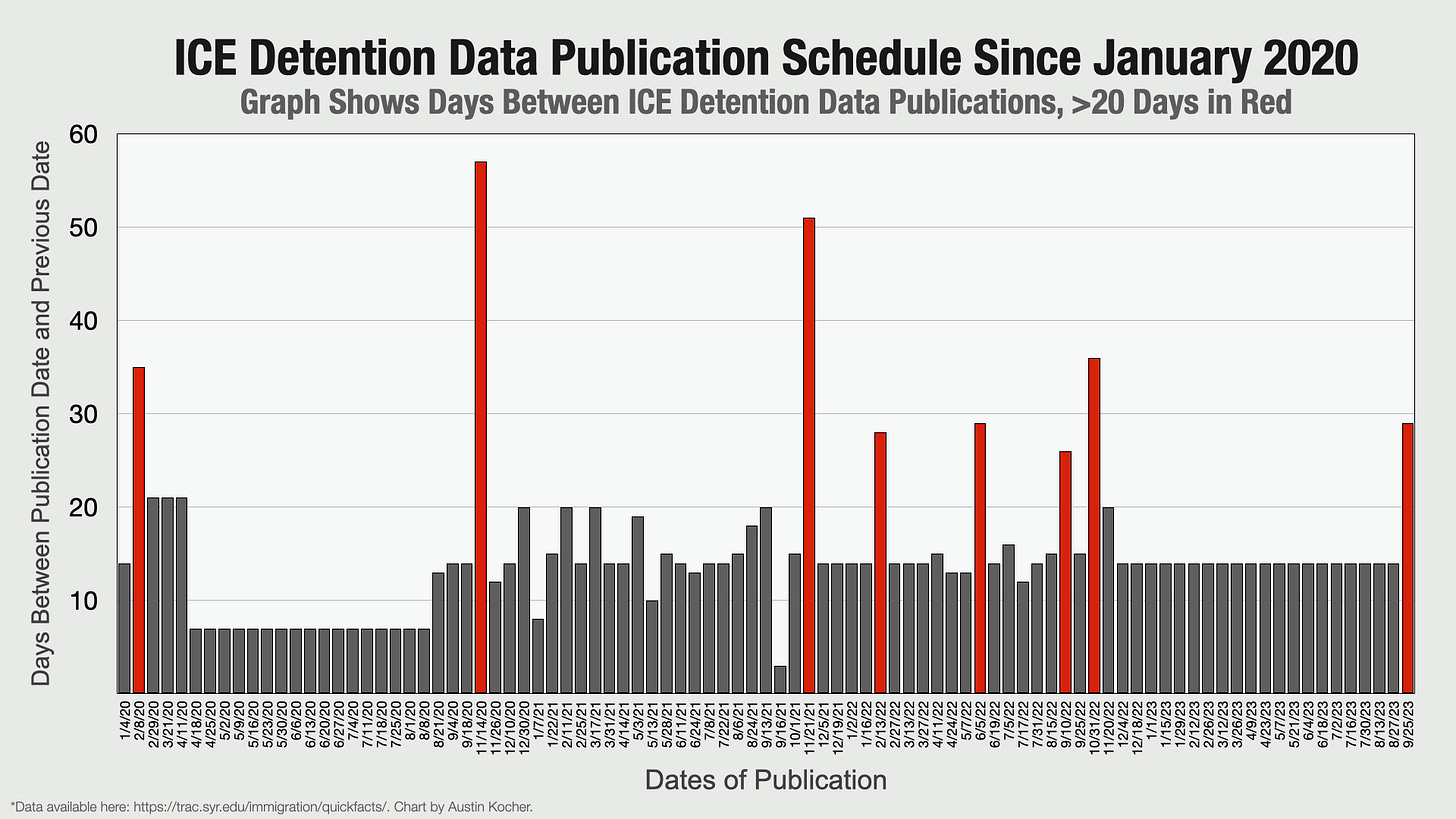Did ICE Forget Something? Agency Fails to Publish Detention Data in a Month
Keep reading to learn more about ICE's missing detention data followed by a discussion of Biden's "record high" immigrant detention numbers.
Immigrant detention hasn’t received nearly as much attention in recent months as border enforcement policies—like the one I shared over the weekend about Mexico stepping up its deportation game. But immigrant detention remains an important and ongoing concern for the public, which is why I wanted to draw attention to the problem of ICE’s missing detention data and discuss the most recent detention data. Before we get into it, I also have a few housekeeping notes.
Housekeeping
ICE’s Missing Detention Data
Record Detention Numbers Under Biden?
Housekeeping
First of all, I don’t pay close attention to subscriber numbers, but I did note this weekend that we crossed 2,500 readers recently which I find to be an enormous honor. The most valuable thing we can give each other is attention, which is why I am careful to respect your attention by keeping these newsletters short, to the point, and fluff-free.
Second, if you like this post about detention and want to read more, I created a section on my Substack homepage for posts about detentions and prisons as well as other themes I often write about (e.g., asylum, book suggestions, etc.). Although my posts are often about current events, I also write them in a way to hold value over time so that they can be used as teaching materials, research, and as a kind of ongoing archive.
1. ICE’s Missing Detention Data
Update: Around 1:30 pm on the date of this post, ICE posted their updated detention data, but it is clearly data they forgot to post ~10 days ago. I will update this post with more information soon.
ICE’s immigrant detention data is a valuable source of information for the public regarding how many immigrants are in detention or in the agency’s alternatives to detention (ATD) program, where immigrants are held, and information about vulnerable detained populations (e.g., trans detainees).
The agency typically publishes this data on a tight 14-day schedule. But as of this morning (Monday, 09/25/2023), the agency has not updated its detention data since 8/31/2023—nearly a month. In fact, because the data contained in the file is typically a few days to a week behind the publication of the data (this is normal, not a criticism), some data (such as the ATD data) is a month old now.
For emphasis, I graphed the average days between publications since the start of this calendar year in January. You can see how consistent the agency has been until this month.
Looking at this made me wonder about how often the agency creates long delays between data publications. One suspicion I had is that the agency would get busier at the end of the fiscal year—in September—with end-of-year reporting requirements. If that drives the delay, I find that unfortunate but somewhat understandable. Agencies don’t have infinite resources. But that doesn’t seem to be the case.
Looking back at data releases to January 2020 doesn’t reveal a clear pattern around the end of fiscal years. I have highlighted intervals longer than 21 days (3 weeks) in red. Delays over the past three years have occurred in October once, November twice, February twice, June once, and September once. I can’t see a pattern in that to represent institutional cycles tied to resources.
So what gives? My good friends at ICE probably hate me for harping on this dataset so much, but it’s one of the very few regularly-produced datasets that the public has access to in an otherwise very closed agency that has been too often resistant to public oversight efforts. The agency hasn’t always managed these data terrifically well: they have mistakenly released old and outdated data, released wildly inaccurate data, and they still don’t publish all of the data that Congress mandated.
2. Record Detention Numbers Under Biden?
On a related note, a few weeks ago there was a surge of reporting around “record detention numbers” under Biden. I believe the intent of this reporting was to show that detention numbers have increased since the state of the Biden administration. I want to applaud the reporter (who shall remain nameless) for having a sober conversation with me about why this both is and is not a story.
The latest data (ahem, a month old) shows that, indeed, detention numbers did reach their peak during the Biden administration of 32,743 at the end of August. And, indeed, those detention numbers have been steady at around 30,000 since June.
There are four additional contextual factors, however, that were not emphasized in the reporting I read. First, as the graph below shows, this is still half of the detention numbers during the Trump administration. Make of that what you will. I agree that we shouldn’t let Trump set the norm, but that’s still an important piece of information.
Second, the Biden administration’s detention numbers started out artificially low due to the pandemic, setting the administration up to see notable growth. Again, we might debate whether immigrants should ever be detained in civil detention centers at all. I’m just noting that understanding the starting point for these data is an essential part of properly contextualizing these numbers.
Third, if we situate these numbers in the context of the number of asylum seekers entering the country—who would have, under previous administrations, probably been detained—these numbers are still relatively low. My politics would probably say that 30,000 detained people is 30,000 too many. But I can also appreciate that there are more generous ways of contextualizing these data.
Fourth, and perhaps least remarked upon, my understanding from talking to people in detained courts is that a very high percentage of the detained population now are not eligible for bond or are unlikely to get bond because the administration simply is not detaining people with less serious offenses. I’m not saying that I, Austin, think that those people who are detained should be detained; only that within the logic of the detention system, ICE is not detaining people indiscriminately like they were under the Trump administration. This is why, perhaps ironically, bond grant rates could actually be higher under the Trump administration compared to the Biden administration. I would like to work that out more empirically, but I’ll leave it there for now.
Support public scholarship.
Thank you for reading. If you would like to support public scholarship and receive this newsletter in your inbox, click below to subscribe for free. And if you find this information useful, consider sharing it online or with friends and colleagues.







Appreciate the context and nuance around the detention numbers. It reminds me of how Title 42 drove up crossing numbers artificially, but on paper you only got half the story
We live 30 minutes from the border and "detention numbers" do not matter in reports - what matters is how many they are letting thru, how many they don't even stop, how many that if seen for amnesty - are simply released into the immediate area and left to their own/and cartels' devices or other bad actors. Detention numbers are numbers that can be "discussed" by those who choose to ignore the open borders for their own distancing and political reasons.